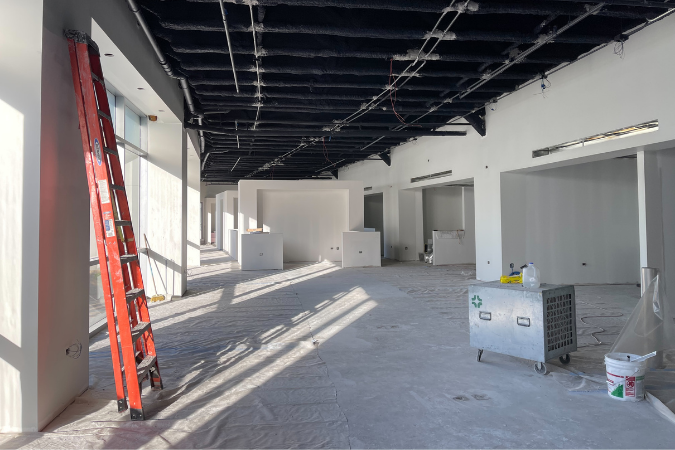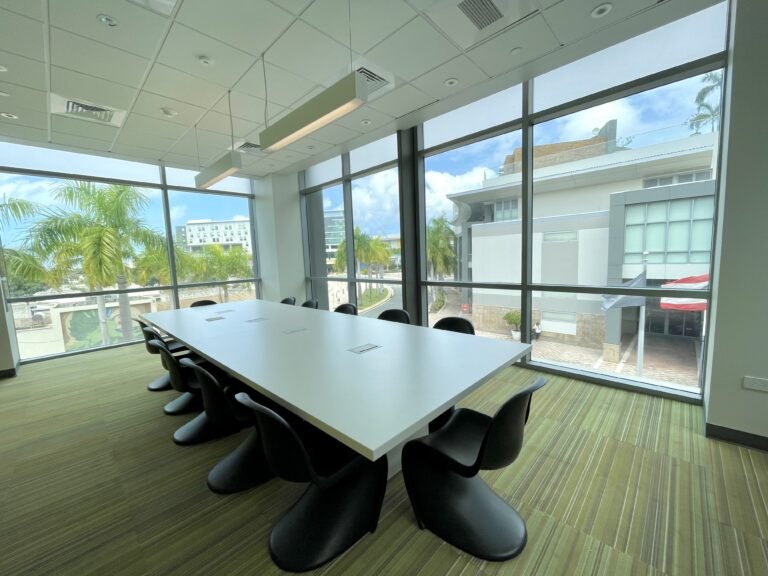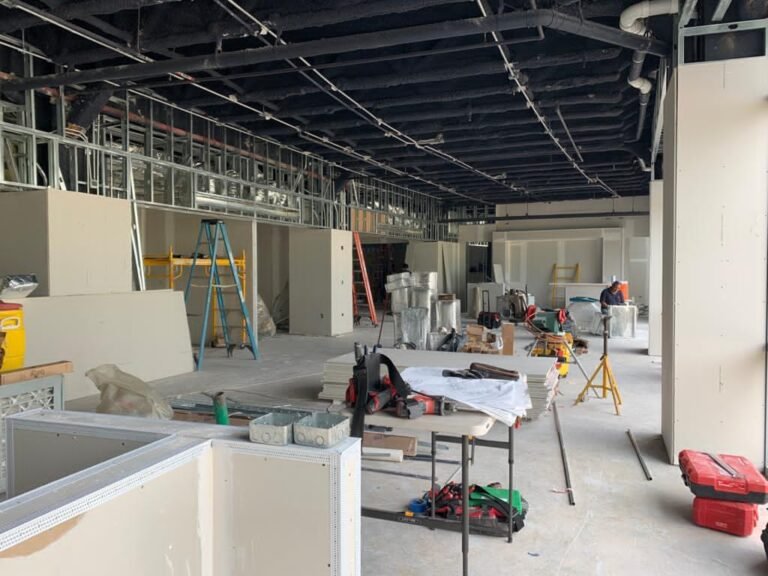20 Tips to Facilitate an Office Move
Written By AD&V®ABOUT THE AUTHOR | AD&V® is dedicated to advanced and energy-efficient sustainable architecture & interior design that enhances people’s experience of the world and improves their lives.
There’s a lot to get done before moving an office. Just thinking about it can be a little overwhelming!
We recently moved our headquarters to a new space and we wanted to share what we learned in case you are tackling a move yourself.
1. KNOW THE OBJECTIVE
Think about why you want to move offices. For us, we needed a space that could accommodate our growing team, especially in COVID times. That’s why we chose a space where our team could collaborate and work comfortably, allowing plenty of space for social distancing and collaboration. Knowing the objective of your move will help you pick the right space for your team.
2. CONSIDER OTHER FACTORS
New AD&V office headquarters main conference room.
You need to take into consideration other important factors when selecting your next office space. Factors such as location, size, design, and safety are essential to think about before choosing your new office. Ideally, the office space you select will be surrounded by amenities or places where your team can walk around, grab some coffee, or have lunch.Choose an office that’s also designed with the size and space available to accommodate meetings, furniture, technology, office culture activities, and lunches. Consider these factors in order to continue to develop your team and business.
3. ASK YOUR TEAM WHAT THEY NEED
The AD&V Team visiting the new office headquarters.
Ask your team what they need before moving into a new office. We recommend interviewing each department in order to understand what their day-to-day workplace needs are. For example, we designed our new office headquarters so that our team could have added storage, phone booths for private conversations or meetings, standing desks, and additional meeting and work areas. Our goal was to improve and encourage the team’s collaboration and productivity using the new office design.
4. PRIORITIZE HEALTH & SAFETY
Make the health and safety of your team your number one priority. It’s important that every single team member feels that they are working in a healthy and comfortable environment. This means making sure that the office space has the facilities to comply with CDC workplace guidelines such as providing sanitation areas, safety kits, and temperature checks. At our offices, we also installed protective glass partitions at the desks as an added safety measure.Additionally, ensure the safety of your team members by choosing a space that provides secure parking, an office alarm, and controlled access to the office. It’s also good to have security patrolling the office building at all times. Our team members have flexible working hours so we these security measures allow them to feel safe even after regular office hours.
5. MAKE LISTS
Once you have officially chosen your new office space, it’s time to create a checklist of what needs to be done before, during, and after the move. We recommend beginning the moving process at least 6 months before the move-in date in order to be able to have enough time to make a seamless transition.
6. CREATE A PLAN
Create a moving plan early on. Assign a moving team, create periodical move-in meetings, set a budget, let team members and the property/building manager know you're moving out beforehand so they can get organized and be able to set everything up in a timely manner.
7. DECLUTTER
New AD&V office headquarters library.
Organize all files, documents and materials, and discard what you don’t need by donating and/or recycling it. Decluttering will let you determine what’s necessary and help you avoid overpacking while saving you money from buying additional boxes too.
8. SAVE & BACKUP FILES
Check that you have all important documents and data stored and backed up in the cloud before starting the move. Your team will probably be working remotely during the move so it’s important that everyone has access to all files.
9. CREATE MORE LISTS
Make a list of everything that’s going to be packed at the office. This includes files, equipment, furniture, fixtures, technology, materials, etc. If you have important documents or a library of books, create an inventory list to keep track of them. You can organize your lists by type, category, or area. Once you know what needs to be packed, then you can make a list of all the packing equipment you need to order like tape, boxes, bubble wrap, etc.
10. ANNOUNCE YOUR MOVE
Let clients know that you're going to be moving to a new office and announce the new address via email blast, press release, and social platforms. Remind them again once you’ve moved, so that they can update your contact information. Don’t forget to update your new office location on Google Maps, the company website, social media, letterheads, business cards, and email signatures. Make it easy for people to find you!
11. PACK RIGHT
Office area filled with packed boxes.
Before you begin packing, organize everything and create labels for your items. Organizing and labeling boxes and items when packing, will avoid mixing everything up and make it easy for you to know where your items are at all times. Start by packing non-essential items first and then work your way towards packing essential items. This means packing the things that are not used as much around the office at the beginning, and then packing the most used and essential equipment towards the end.
12. USE WHAT YOU HAVE
People moving former AD&V office furniture.
When we moved into our new headquarters, we brought our former office decor, furnishings, fixtures, materials, and equipment with us as part of our sustainable mission to reduce our environmental impact. Reusing what you can from your former office will be more cost effective, while helping out the environment at the same time.
13. BOOK IT
Empty former AD&V office space.
Book the office movers, construction workers, and a cleaning crew to clean up before and after the move. If you’re taking furnishings and equipment with you, make sure you also arrange for them to uninstall and reinstall them at the new office. Hiring the right team will help speed up the moving process.
14. SECURE STORAGE
Storage room filled with boxes and furniture.
If your new office doesn’t have a storage space where you can use to store boxes and items while the new office is getting ready, we recommend reserving a storage unit nearby.
15. SET THE INTERNET & PHONE PROVIDER
Coordinate with your IT Department to schedule the set-up of the server, internet and phoneprovider at the new office in order for your team members to be able to work in the new space. Make sure the provider visits the space ahead of time to identify any potential problems or challenges with setting up internet service. It’s more important than ever to be connected and even one day without internet can represent huge challenges for your team.
16. TIE LOOSE ENDS
Before beginning the move to the new office, talk to the property/building manager to leave everything set before you leave. Make a list of every team member's keys, parking passes and access cards to ensure that all items are returned to the property/building manager. Similarly, deliver the new office keys, parking passes, and access cards to your team before going to work at the new office.
17. SUPERVISE THE MOVE
New AD&V office headquarters construction.
Be present to supervise the move so you're aware of what’s finished, what needs to be done and what has to be changed. More importantly, maintain active communication with everyone that's working on the move, so you don’t miss any important details that need to be attended to.
18. CREATE A PUNCH LIST
Create a punch list before officially finalizing the move to your new office. Use the list to verify all that’s been done, what’s currently being done, and whether there are things still left to do. The punch list will help you determine what needs to be done and by when, before the team starts working at the new office.
19. KNOW WHO TO CALL
Get acquainted and save the contact information of the new building/property manager, maintenance staff, and security staff. That way you know who to call once you move in and situation inevitably arise.
20. MAKE TIME TO ORGANIZE
New AD&V Office Headquarters Studio space.
Once officially moved in, allow your team time to be able to set up their equipment and organize their belongings before jumping right back in to work. Having everything organized will allow for a seamless transition into work. Even though moving can be daunting, organizing, planning and getting the ball rolling beforehand, will help you make the moving process much smoother. Establishing clear communication with everyone involved in the process will also create a smoother transition. Moving into a new space is exciting and filled with new energy and possibility. All the hard work and coordination will be worth it once you see your team enjoying their new beautiful space!










